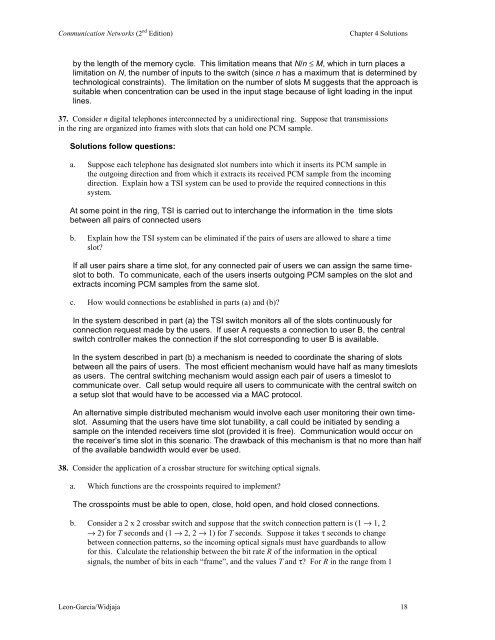Solutions to Chapter 4 - Communication Networks
Solutions to Chapter 4 - Communication Networks
Solutions to Chapter 4 - Communication Networks
You also want an ePaper? Increase the reach of your titles
YUMPU automatically turns print PDFs into web optimized ePapers that Google loves.
<strong>Communication</strong> <strong>Networks</strong> (2 nd Edition)<br />
<strong>Chapter</strong> 4 <strong>Solutions</strong><br />
by the length of the memory cycle. This limitation means that N/n ≤ M, which in turn places a<br />
limitation on N, the number of inputs <strong>to</strong> the switch (since n has a maximum that is determined by<br />
technological constraints). The limitation on the number of slots M suggests that the approach is<br />
suitable when concentration can be used in the input stage because of light loading in the input<br />
lines.<br />
37. Consider n digital telephones interconnected by a unidirectional ring. Suppose that transmissions<br />
in the ring are organized in<strong>to</strong> frames with slots that can hold one PCM sample.<br />
<strong>Solutions</strong> follow questions:<br />
a. Suppose each telephone has designated slot numbers in<strong>to</strong> which it inserts its PCM sample in<br />
the outgoing direction and from which it extracts its received PCM sample from the incoming<br />
direction. Explain how a TSI system can be used <strong>to</strong> provide the required connections in this<br />
system.<br />
At some point in the ring, TSI is carried out <strong>to</strong> interchange the information in the time slots<br />
between all pairs of connected users<br />
b. Explain how the TSI system can be eliminated if the pairs of users are allowed <strong>to</strong> share a time<br />
slot<br />
If all user pairs share a time slot, for any connected pair of users we can assign the same timeslot<br />
<strong>to</strong> both. To communicate, each of the users inserts outgoing PCM samples on the slot and<br />
extracts incoming PCM samples from the same slot.<br />
c. How would connections be established in parts (a) and (b)<br />
In the system described in part (a) the TSI switch moni<strong>to</strong>rs all of the slots continuously for<br />
connection request made by the users. If user A requests a connection <strong>to</strong> user B, the central<br />
switch controller makes the connection if the slot corresponding <strong>to</strong> user B is available.<br />
In the system described in part (b) a mechanism is needed <strong>to</strong> coordinate the sharing of slots<br />
between all the pairs of users. The most efficient mechanism would have half as many timeslots<br />
as users. The central switching mechanism would assign each pair of users a timeslot <strong>to</strong><br />
communicate over. Call setup would require all users <strong>to</strong> communicate with the central switch on<br />
a setup slot that would have <strong>to</strong> be accessed via a MAC pro<strong>to</strong>col.<br />
An alternative simple distributed mechanism would involve each user moni<strong>to</strong>ring their own timeslot.<br />
Assuming that the users have time slot tunability, a call could be initiated by sending a<br />
sample on the intended receivers time slot (provided it is free). <strong>Communication</strong> would occur on<br />
the receiver’s time slot in this scenario. The drawback of this mechanism is that no more than half<br />
of the available bandwidth would ever be used.<br />
38. Consider the application of a crossbar structure for switching optical signals.<br />
a. Which functions are the crosspoints required <strong>to</strong> implement<br />
The crosspoints must be able <strong>to</strong> open, close, hold open, and hold closed connections.<br />
b. Consider a 2 x 2 crossbar switch and suppose that the switch connection pattern is (1 → 1, 2<br />
→ 2) for T seconds and (1 → 2, 2 → 1) for T seconds. Suppose it takes τ seconds <strong>to</strong> change<br />
between connection patterns, so the incoming optical signals must have guardbands <strong>to</strong> allow<br />
for this. Calculate the relationship between the bit rate R of the information in the optical<br />
signals, the number of bits in each “frame”, and the values T and τ For R in the range from 1<br />
Leon-Garcia/Widjaja 18







